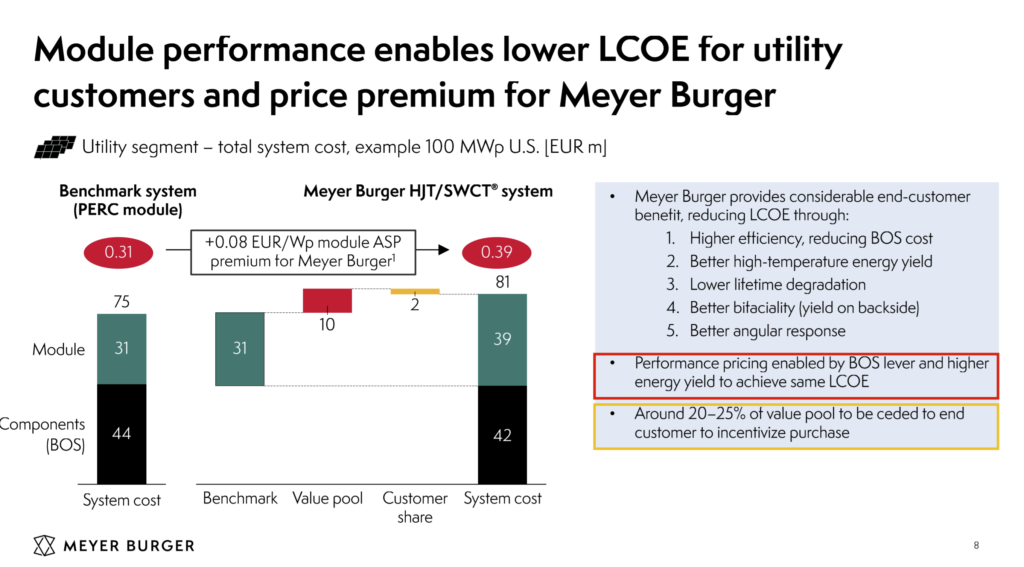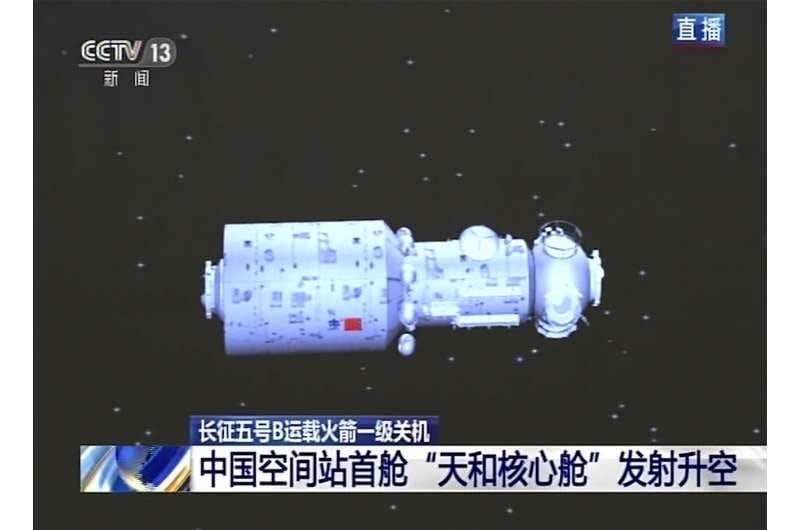Today from the Clean Power Hour, we discuss the Meyer Burger solar panel pricing, refreshing versus recyling lithium ion batteries, the new Chinese space station, and more! This excessive commentary is brought to you by Tim Montague and yours truly – the CommercialSolarGuy – John Fitzgerald Weaver.
First, here’s the podcast – now on to the news:
Meyer Burger’s evolution into a solar cell and module manufacturer
First, we did a great podcast interview with Meyer Burger’s CEO and their Americas President last week – that podcast is located here. Second, on this weeks show we talked about them. Specifically, Tim found the company’s April 2021 Corporate Presentation – and within that presentation we found a few gems. The first slide, the article’s main image, is of the company is aiming for a 27.8% solar module in 2023! That’s right around the corner, and would result in a momentous leap from solar’s current 20-22% efficiency window. This product will be based on the OxfordPV perovskite+silicon tandem heterojunction solar panel – which we’ve covered here.
The slides below give us indicative pricing for residential and commercial sized modules. In the USA – expect the pricing to be 15% higher due to the Trump Solar Tax, plus distribution and shipping markups. (So, maybe 60¢/W for residential panels and 50¢/W for commercial/utility?)
Renewable Energy Is Suddenly Startlingly Cheap
In 2015, zero per cent of solar’s technical potential was economically viable—the small number of solar panels that existed at that time had to be heavily subsidized. Recently, the International Energy Agency said, “For projects with low-cost financing that tap high-quality resources, solar PV is now the cheapest source of electricity in history.”
China launches main part of its 1st permanent space station
The Tianhe, or “Heavenly Harmony,” module blasted into space atop a Long March 5B rocket…launch begins the first of 11 missions necessary to complete, supply and crew the station by the end of next year…T-shaped Chinese Space Station is expected to weigh about 66 tons…launch furthers the “three-step” strategy of building up China’s manned space program The Sky’s the Limit: Solar and wind energy potential is 100 times as much as global energy demand
…often we hear people complain about where we will place wind and solar, and how it isn’t possible to power us because of this. These people are wrong. We could power the earth ten times over with wind turbines floating in the middle of the ocean if we wanted.
With current technology and in a subset of available locations we can capture at least 6,700 PWh p.a. from solar and wind, which is more than 100 times global energy demand. The land required for solar panels alone to provide all global energy is 450,000 km2, 0.3% of the global land area of 149 million km2 – less than the current land footprint of fossil fuel infrastructure.
The Wave Swell Energy (WSE) technology is based on the well-established concept of the oscillating water column (OWC)
…After we covered water turbines on last weeks show, IsthmusEnergySystems on Twitter brought this technology to our attention.
The OWC is an artificial blowhole consisting of a chamber that is open underneath the waterline. As waves pass the OWC, the water rises and falls inside, forcing the air to pass by a turbine at the top of the chamber. This turbine generates electricity. Previous OWC technologies have all been bidirectional. The WSE technology, however, operates unidirectionally. This results in the WSE turbine being simpler, more robust and reliable, and exhibiting a higher energy conversion efficiency. The only moving parts in the technology are the turbine and bespoke valves, all of which are well above the water line. There are no moving parts in or below the water.
Lithium saturation to make old batteries new
“We noticed that one of the main causes of battery deterioration is the depletion of lithium in the electrode material,” explained Aalto University professor Tanja Kallio. “The structures can nevertheless remain relatively stable, so we wanted to see if they can be reused.” The group found that the re-lithiation process served to restore the original electrode structure, and demonstrated capacity, rate capability, and cyclability properties only slightly behind the brand new batteries.
The EU carbon price broke about 50 euros for the first time
…Per the U.S. Energy Information Administration, coal generates 2.1 pounds of CO2 per kWh, and gas 0.91 pounds per kWh. That calculates to 997 kWh from coal per metric tonne, and 2,422 kWh per metric tonne from natural gas. Divide the €50 ($60/USA) into that number, and you get a tax of 5¢/kWh for coal and 2¢/kWh for gas. If you’re an average American, that’d be a carbon tax of ~$500-600/year if you were 100% coal powered, and $200-250/year if 100% gas powered. Of course, we’re about 40-50% CO2 free in the USA on average, but we have great variance between regions.
The cost of pollution in the European Union exceeded 50 euros ($60) per metric ton for the first time https://t.co/wANOOpyEMC via @MathisWilliam pic.twitter.com/Iki63CpbS6
— Helen Robertson (@HelenCRobertson) May 4, 2021
Instant permits for home solar? There’s a SolarApp for that
Department of Energy-funded app designed to drastically speed up permitting for home solar projects, called Solar Automated Permitting Processing Plus (SolarApp+). When rolled out across software programs, the app will be available for free to governments. Solar installers must pay a fee of $25 per application. NREL’s plans to expand it to a wider swath of jurisdictions will be supported by a partnership with Accela, which provides government software to more than 80 percent of the largest cities in the U.S., according to the company.
Longi sets TOPCon cell record of 25.09%
…TOPCon is a solar cell type that has an extra layer of silicon type materials injected. Prior to this cell, Jinko held the record at just short of 25%, and actually made a solar panel from it that just broke 23% efficiency. If LONGi and Jinko start delivering 23% efficiency solar panels in massive volumes to the world – that’ll mean a whole lot of savings on Balance of Systems.
The achievement, confirmed by Germany’s Institute for Solar Energy Research in Hamelin for Longi’s monocrystalline, n-type, bifacial product, marks the first time a device of such scale has breached the 25% barrier.
And now, the podcast:



